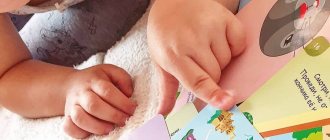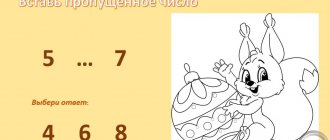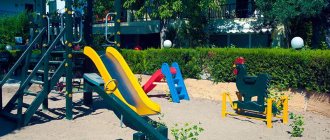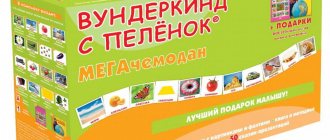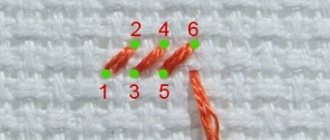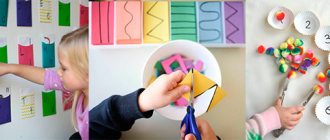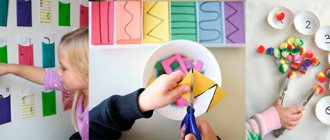The didactic game “Patterns” is intended for independent and joint lessons with a teacher by preschoolers of the primary and secondary groups. It develops concentration, observation, imagination, finger motor skills, and visual perception. The purpose of the game “Patterns” is to form ideas about different patterns, teach the skill of composing compositions, selecting elements by shape and color.
Didactic game “Fold the pattern”
There are several classes on this topic. They all perform the following tasks:
- are taught to put together a whole from several parts;
- introduce colors and shapes, their names;
- teach the skill of composing images based on a model;
- develop imagination, creative thinking, the ability to see images of the real world in abstract forms and lines;
- train the ability to analyze, compose, combine;
- improve concentration, spatial-temporal orientation, thinking ability, visual memory, finger motor skills;
- They teach you to cooperate, interact productively, and respond emotionally.
To play, you need to prepare a laminated image of the national ornament and cut it randomly into several parts.
At the preliminary stage, children look at book pictures depicting national patterns. Then the teacher suggests putting together an ornament from parts. To make it easier for preschoolers, there should be a sample in front of their eyes.
Card index of didactic drawing games for senior preschool age
Card index of didactic drawing games for children of senior preschool age.
“Collect landscape and still life”
“By the example of landscape and still life it is convenient to develop a sense of composition”
Purpose of the game: to develop compositional thinking skills, consolidate knowledge of the concepts of “landscape” and “still life”, develop observation and memory.
Progress of the game: the child is asked to create a landscape and a still life from a set of pictures, select objects, and build the correct composition.
3. “Imagine a landscape”
3-6 children can take part in the game.
Purpose of the game: to train children in composing a composition with multifaceted content, highlighting the main size. Exercise children in composing a composition united by a single content. To consolidate children's knowledge about seasonal changes in nature. Clarifying children's knowledge about landscape as a form of painting. Develop children's observation skills and creative imagination.
Progress of the game: the child is asked to create a landscape of a certain season - winter, spring, autumn or winter - from a set of pictures; the child must build the correct composition corresponding to this particular time of year.
ASSEMBLE THE FIGURE FROM THE PICTURE
The teacher tells the children that they will collect different figures. Shows one of the pictures, for example a dog, and offers to assemble the same dog from parts. Children create the proposed image and check whether it matches the given pattern. Then you can offer another picture or give all the diagrams to the children so that they collect the shapes and exchange parts.
2. Didactic game “What is it like?”
Goal: to teach children to create images in their imagination based on schematic representations of objects.
The game consists of a set of cards with various figures. Each card has a figure drawn on it, which can be perceived as a detail or an outline image of an object.
An adult invites children to play a game. He will show them a picture from the set and ask the children what it looks like. The teacher strives to ensure that each child comes up with something new that none of the children have yet said. The game can be repeated several times, using new material each time. The cards are laminated, so you can give the children felt-tip pens and they can complete the picture themselves.
3. Didactic game “Find an object by silhouette”
Purpose: To give children an idea of the shadow. To develop the ability to find silhouettes by superimposing.
The presenter gives the children cards with the given silhouettes. Invites children to look at them. Then the presenter shows one of the cards with the image. Children must find the desired silhouette among the cards they have. If the child finds the card correctly, he puts a shadow on the color image.
Make a bouquet
Target:
1. Teach children to distinguish between warm and cold colors, fix their names in the active dictionary 2. Fix generalizing words in children’s speech: warm, cold (colors) - and practice using these words Game material: 1. 2 pictures. On each one I drew a flower vase. There are green stems in the vases. At the ends of the stems, glue circles of neutral color (gray, white) made of flannel or velvet paper. One vase has a warm color pattern, the other a cold one. 2. Flower heads cut out of paper of different colors: blue, blue, violet (cold tones); yellow, orange, red (warm colors). Glue the flowers on the back side with velvet paper or flannel.
Progress of the game
The teacher shows the children pictures with vases and suggests making 2 bouquets: one of warm-colored flowers, which resembles the color of fire. And the other - cold tones, which are similar to the color of the sky, water, ice floes. The teacher sets up a flannelgraph, on which he attaches flower heads in disarray. He calls two or four children to perform the exercise. Children find the right flowers and attach them to the ends of the stems, then talk about their bouquets, for example: “I made a bouquet of red, orange and yellow flowers, My bouquet of warm-colored flowers” Or “My bouquet of cool-toned flowers - blue, blue and purple"
“Autumn Palette”, “Spring Palette”, “Seasons”, children select a color scheme for a certain time of year and consolidate knowledge about seasonal changes in nature.
Didactic game “Magic Colors”
Goal: during the game, to develop children’s attention and interest in various colors and shades, a feeling of joy when perceiving the beauty of nature.
Material: cards with different colors.
How to play: Give children cards with squares of different colors. Then the teacher says a word, for example, birch. Those children who have black, white and green squares raise them up.
Then the teacher says the next word, for example, rainbow, and the squares are raised by those children whose colors correspond to the colors of the rainbow. The children’s task is to respond as quickly as possible to the words spoken by the teacher.
Didactic game “Mix the colors”
Goal: to introduce children to primary and composite colors, the principles of color mixing.
Material: cards with pictures of girls-paints, signs “+”, “-”, “=”, paints, brushes, paper, palette.
Progress of the game: Children are asked to solve examples by mixing colors, for example, “red + yellow = orange”, “green + yellow = blue”.
"Portraits"
Goal: teach children to draw a head using templates. Materials: a sheet of paper with a drawn oval of the face; cardboard templates of eyebrows, eyes, nose, lips, ears, hairstyles. Children’s actions: lay out the head on a piece of paper, trace it, color the resulting portrait
"Collect a matryoshka doll"
Goal: To develop a sense of form.
Material: Pictures depicting different castles. Paper. Markers. Assignment: The teacher asks the child to look at the picture and name what shapes the castle shown in the picture consists of. Color the picture.
“Complete the objects”
Goal: To strengthen with children the idea of symmetrical objects, familiarization with the profession of a potter.
Materials: Templates for jugs, vases and pots, cut along the axis of symmetry.
Assignment: The potter broke all the pots and vases that he made for sale at the fair. All the fragments were mixed up. We need to help the potter collect and “glue” all his products.
"Create a pattern"
Goal: to develop the ability to compose a pattern according to a model, taking into account the spatial relationships between elements.
Game task: place the necessary elements on a napkin (mat, scarf, checking the sample (according to your plan, as directed by the teacher). Number of players: 2-3
"Cut pictures"
Goal: To consolidate knowledge about the means of expression used in Dymkovo painting, to practice composing a whole picture, to develop attention, concentration, the desire to achieve results, observation, creativity, and to arouse interest in objects of decorative art.
Material: Two identical planar images of various objects, one of which is cut into pieces (you can prepare options for cut products, dividing them into four to eight parts of different geometric shapes). Game rules. Quickly assemble a product from individual parts in accordance with the sample.
Progress of the game. One child or a group can take part in the game. The teacher shows samples and gives the opportunity to look at them carefully. At a signal from an adult, the players assemble an image of a product from parts. The one who completes the task first wins.
"Third wheel"
Goal: to teach children to identify from three toys the extra one that belongs to a different craft.
Progress of the game: children are offered one by one several options for combining toys: two Dymkovo toys and one Khokhloma spoon; two Gorodets boards and one Dymkovo toy; two Dymkovo toys and one Gzhel plate. The child must say which two objects belong to the same craft, and which object is superfluous. Ask your child to comment on his answer. Ask what these toys are called. In case of difficulty, the teacher names folk toys - Dymkovo, Gzhel and Gorodets.
"Continue the pattern"
Goal: To strengthen children’s ability to draw a Dymkovo pattern based on Dymkovo painting.
Material: Elements of Dymkovo paper painting.
How to play: Players choose cards with a picture. Continue drawing, using the started painting elements, selecting the color scheme and the given element.
"Gorodets patterns"
Didactic tasks: to consolidate children’s ability to compose Gorodets patterns, recognize the elements of painting, remember the order of the pattern, and independently select the color and shade for it. Develop imagination, the ability to use acquired knowledge to compose a composition. Material: stencils of Gorodets products made of yellow paper (cutting boards, dishes, etc., a set of elements of Gorodets painting (paper stencils). Game rules: children are offered a set of plant elements and figures of a horse and a bird. They must lay out a pattern on the stencil using the appliqué method.
"Dymkovo mosaic"
Goal: To clarify and consolidate the idea of the elements of Dymkovo painting, to develop memory and compositional skills. Foster a desire to create original Dymkovo toys.
Material: planar images of various Dymkovo toys, a set of small planar elements of Dymkovo patterns.
How to play: Invite children to create their own Dymkovo toy.
“Find the composition element”
Target:
clarify and consolidate the idea of the main elements of any painting, learn to isolate individual elements of a pattern and figure. Develop observation, attention, memory and speed of reaction, arouse interest in painting.
Material: large cards, decorated with some kind of painting, which have free windows.
Small cards with individual pattern elements, including painting options or shapes.
Game rules: determine which of the proposed cards depicting elements of the painting match the pattern elements of the main card.
Progress of the game: having received a large card and several small ones, having carefully examined them, the players select those elements that are found in the pattern and place them in empty windows. The leader monitors the correct completion of the task.
Didactic game “Assemble a pattern”
For the lesson you need to draw silhouettes of Dymkovo figures - a cockerel and a horse. Separately cut out the details of the Dymkovo pattern: circles of different colors and sizes, flowers, leaves, straight and winding stripes. Also, as a sample, you need to make pictures of toys with ornaments on them.
The teacher places full pictures of toys and empty silhouettes in front of the children, and lays out the cut-out parts on the table. He asks the students to carefully look at what the horse and cockerel look like and decorate the silhouettes in the same way.
The task can be complicated: remove the complete drawing so that the children can decorate the silhouettes from memory, or invite them to come up with their own ornament from the details.
Didactic game “Pick a pattern”
For the lesson, prepare game material:
- take light A4 cardboard and white plastic drink lids;
- Divide the cardboard sheet into squares of equal size;
- there should be one cap for each sector;
- With a black marker, draw a pattern on each square, similar on the corresponding lid (it should not be repeated on other squares and lids);
- Laminate cardboard with transparent adhesive tape to extend its service life.
The players' task is to find a suitable cap for each square. The activity is exciting, preschoolers play willingly, thereby developing memory, concentration and perseverance.
Website about children, games for children, child development
This site is for parents about children. Here you will find different games for children: educational games for children of different ages, ideas for outdoor games for your child, games for children outdoors in summer and winter. In general, this site is dedicated to everything that can help parents understand their child and is dedicated to the upbringing and development of children.
By creating this site, we set ourselves the task of collecting the largest possible collection of information in order to help parents in the development and upbringing of their children. For the most part, children's perception of the world around them occurs through games. Therefore, the section dedicated to games for children is one of the main sections of this site. Considering the computer specifics of the Internet, you can easily find many computer and online games for children of different ages. However, we tried to focus on simple everyday games for children of preschool and school age, which parents can play with their children on the way to kindergarten or the store, on the street or at home. Some games will require special materials that are easy to make yourself, for example, cubes, multi-colored cards, etc. Naturally, we couldn’t ignore online games. However, on this site you will find many entertaining ideas for playing and developing your child without the help of a computer.
In order to follow the news of the site: new games for children, new tricks, new interesting crafts for children, you can use the Yandex widget. This is a small picture at the bottom of the Yandex home page, which shows several of the latest materials published on the site, immediately after they appear.
An entire section of the site is called magic tricks for children . Tricks are not just interesting for children, they cause surprise and delight for kids. Many tricks are based on knowledge of physical and chemical phenomena. By showing children such tricks or revealing their secrets, the child gets to know the world in an accessible and playful way.
An equally interesting section of the site is called origami for children . Just like the previous section of tricks for children, origami arouses children’s genuine interest in constructing paper figures. As a result of the creative process, the child not only creates a tangible result, but also acquires skills that he can show off to other children. It is especially interesting to observe the surprise of children when a three-dimensional figurine of an animal or some object is obtained from a flat sheet of paper. Especially if the paper figurine can still move, such as the classic origami paper Japanese crane figurine can flap its wings.
You can spend your free time with your child usefully by offering to make a craft with your children. Crafts for children are not only a fun way to spend time with your child, but also the development of children’s creative skills, neatness, and most importantly, imagination. Every child will be pleased to make something on their own, and most importantly, in this way the child will be able to independently make a gift for mom, dad, grandparents or sister and brother. Some crafts for children may be interesting not only for children, but also for adults. Try making a matchstick house with your child without glue. You will find this and other interesting ideas in the section on crafts for children.
